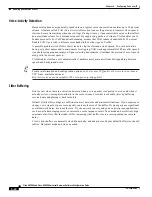
6-15
Cisco AS5350 and Cisco AS5400 Universal Gateway Software Configuration Guide
OL-3418-02 B0
Chapter 6
Configuring Voice over IP
Voice QoS Basics
*Apr 26 21:46:36.435: Data Len : 41
*Apr 26 21:46:36.435: Data : Session 0x0144 Ecan State 0x0007 Restored
Voice QoS Basics
Quality of service refers to the ability of a network to provide differentiated service to selected network
traffic over various underlying technologies. QoS is not inherent in a network infrastructure. Rather, you
institute QoS by strategically enabling appropriate QoS features throughout an intranetwork or
internetwork.
Voice traffic differs from data traffic in a number of ways:
•
Data is often bursty by nature; voice is deterministic (smooth).
•
Data applications resend dropped packets; voice applications can only conceal dropped packets.
•
Data applications can usually tolerate some delay; voice applications must minimize delay, so that
the recipient does not hear clips in the transmission.
All of these mandate use of QoS strategies to give strict priority to voice traffic, ensuring reliable
delivery and minimal delay for networks that carry both voice and data.
Note
The ITU-T G.114 recommendation specifies, for good voice quality, that no more than 150 ms of
one-way, end-to-end delay should occur. In many situations, 200 ms may be acceptable.
QoS features for voice focus on two things—reliability and predictability. Reliability ensures delivery
without packet loss. Predictability ensures delivery without excessive delay. Together, they serve to
eliminate poor-quality voice transmission, including crackles and missing syllables that render a call
unsatisfactory or even incoherent to the recipient.
Voice traffic requires real-time service, with steady and predictable throughput and low delay. In the
presence of bursty, delay-tolerant data traffic, you must provide for voice traffic a differentiated—that
is, higher-priority—level of service. Because networking equipment and devices that carry both data and
voice cannot differentiate traffic that requires high-priority service from traffic that does not, your only
means for ensuring that voice traffic is expedited or that it receives constant, predictable transmission
across a backbone shared by data traffic is by enabling QoS features.
Effective end-to-end QoS throughout a network must serve disparate users, applications, organizations,
and technologies, all at reasonable cost and effort. QoS features enable you to balance service levels for
user satisfaction, granting priority service to voice while servicing data transmission to the degree of
fairness that you require. In addition, other benefits can accrue: Internet service providers (ISPs), for
example, can selectively enable QoS features so as to offer their customers differentiated services with
different associated costs, as well as a spectrum of new applications and additional services based on
these levels of service.
Cisco IOS software provides many features for optimizing QoS. Fine-tuning your network to adequately
support VoIP almost certainly involves enabling some of these features. Be sure to read the sited
references as you enable features, as the details of wide-scale QoS deployment are beyond the scope of
this document. Also, keep in mind that you must configure QoS throughout your network, not just on the
devices running VoIP, to optimize voice performance.
Not all QoS features are appropriate for all network devices and topologies. Edge devices and backbone
devices do not necessarily perform the same operations. Briefly, edge devices handle packet
classification, fragmentation, queuing, bandwidth management, and policing; backbone devices handle








































